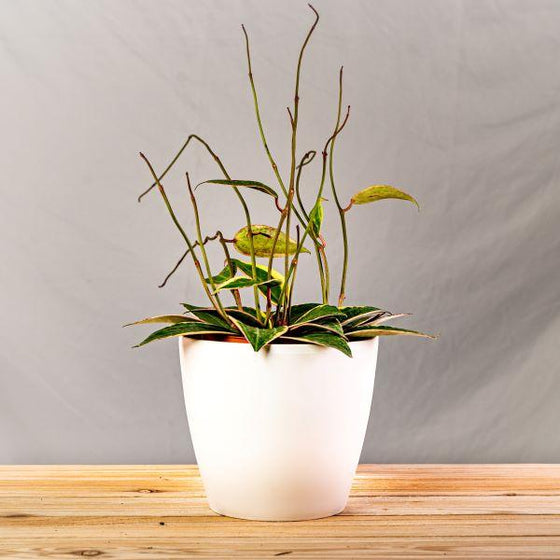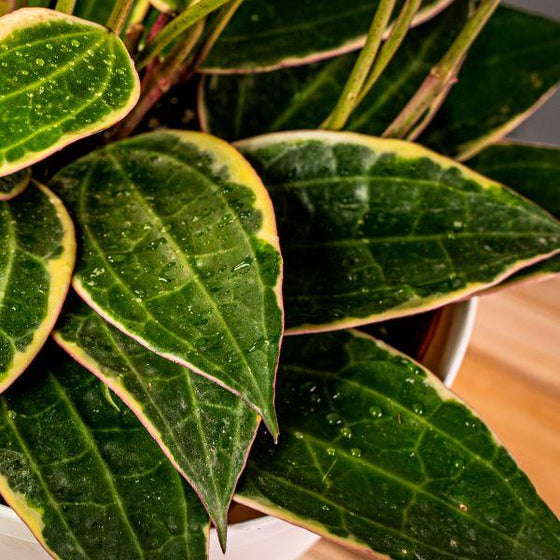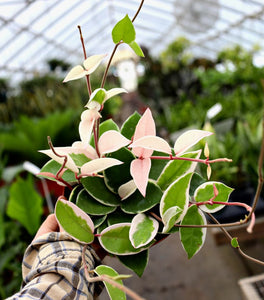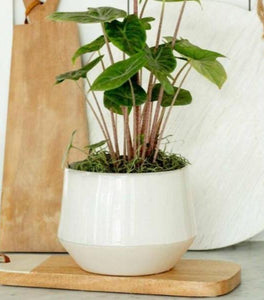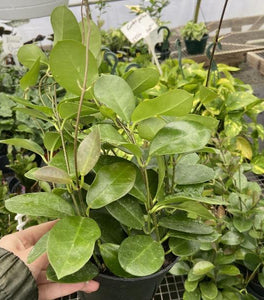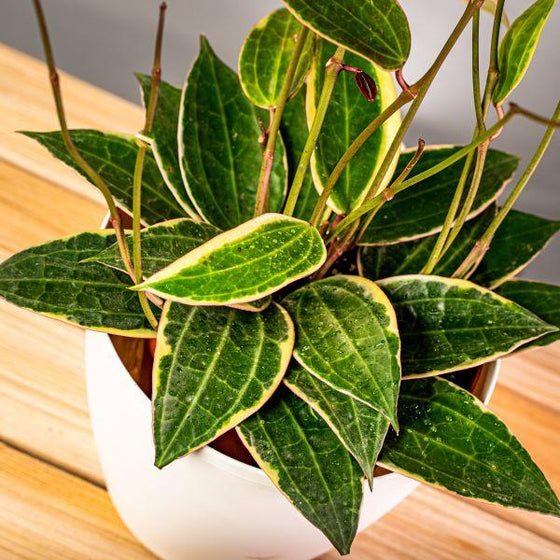
Images Depicted Range in Maturity & Container Size
Pots & Decorations Not Included Unless Otherwise Stated
Macrophylla Variegata Hoya Wax Plants for Sale Online
Hoya Macrophylla Variegata is popular and unique vining houseplant. The exotic specimen is loved for its green and white variegated foliage, climbing tendencies and clusters of pink and white fragrant blooms.
Much like the Hoya carnosa, the Macrophylla Variegata has variegated foliage that is wide and has distinctive creases in the leaves.
Nicknamed the 'wax plant' or 'porcelain flower,' the Hoya Macrophylla boasts oval-shaped waxy leaves that emerge with a slight pink coloring and mature into a deep green. The blooms are little balls of star-shaped petals that are so encapsulating they almost look fake.
Ideal conditions for the Hoya Macrophylla plant include a bright indirect filtered light and a well balanced fertilizer in the growing seasons of spring and summer. Place your Hoya in a south or west facing window for best results.
The watering schedule of the tropical wax plants is similar to that of a succulent. These plants are fairly drought tolerant and enjoy to dry out completely in between waterings. A well draining soil mix and a pot with drainage holes is crucial in protecting your Hoya plant from root rot.
These plants look great in a hanging basket, but will also create a stunning vertical accent if given a moss pole or trellis to climb. As an added bonus, stem cuttings of Hoyas can be easily propagated to produce more plants.
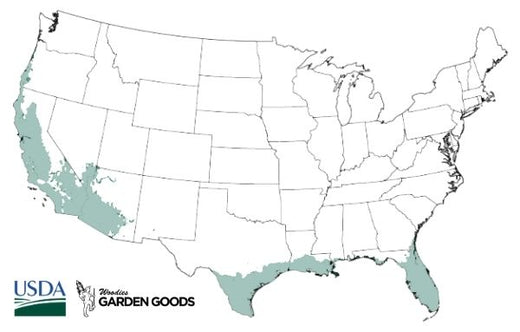
| Hardiness Zone: | 9-11 |
|---|---|
| Mature Height: | 11 to 18 Inches |
| Mature Width: | 30 to 36 Inches |
| Classification: | Succulent |
| Sunlight: | Fluorescent to bright indirect |
| Habit: | Cascading |
| Flower Color: | Pink and white |
| Foliage: | Green and wax like |
| Water Requirement: | Likes to dry out some between watering |
| Uses: | Attractive plant to be featured or in the background of any room in the house, does well with minimal care |
How to Care for Hoya Macrophylla Variegata
Be sure to read our planting instructions to ensure a healthy and happy plant for years to come!

What type of light does the hoya plant need?
Hoya can be grown successfully in low, medium, or bright light. It tolerates low to medium light but won't typically bloom in these conditions. Usually, with flowering houseplants, the more sunlight the plant gets, the more flowers it will produce.
When should I water my Hoya macrophylla variegata?
The Hoya macrophylla variegata should be watered relatively infrequently, as the plants like to dry out some between watering. The easiest way to tell if a plant needs to be watered is by the weight of the container. If the container is very heavy and the foliage is upright, chances are good the plant doesn’t need water, whereas a light container and limp foliage means the plant needs some water. Sometimes, water pours out of the container without being retained by the soil. Soaking the dry soil in a small dish or saucer can be a useful way to solve this problem. It is important not to water the foliage of these plants, or to over-water them as this will lead to leaf damage or plant death. If you’re unsure, it is always better to let the plant go dry instead of drenching it with water. Moisture meters are another easy way to tell if plants need to be watered, and usually come with a guide to indicate what number or level of moisture different plants require.

What is the best soil for Hoya macrophylla variegata?
The best soil for Hoya macrophylla variegata is a well balanced mix of peat moss, perlite and vermiculite that dries some between watering but takes a long time to compact. Typically, any reputable potting mix will work well and includes those ingredients. Adding a granular, slow release fertilizer while planting is a good way to help the plant thrive in the transplanting transition however if the soil you’ve chosen already has fertilizer incorporated into it there will be no need to add additional fertilizer.
What type of Fertilizer does a Hoya macrophylla variegata need?
Indoor houseplant fertilizers fall into two groups: water soluble (liquid quick release), and granular, slow release fertilizers. Jack’s Classic Indoor plant food works well as a powder, quick release fertilizer that is mixed with water to quickly provide nutrients to a plant that has been in a container for an extended time. On the other hand Osmocote Indoor/Outdoor is an option as a granular, slow release fertilizer that can be applied while potting and planting. Any type of fertilizer offers nutrients that help plants with the transition to a new environment.

